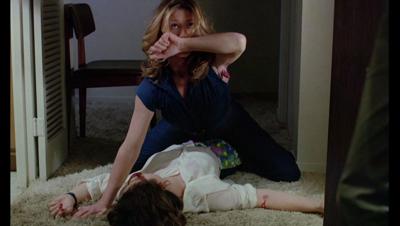Consider these scenes from the snow-dusted world of Canadian horror films, where the ordinary turns strange and insanity reigns.
In David CronenbergÔÇÖs ÔÇťRabid,ÔÇŁ a distressed woman asks a man for a hug. She then stabs him with her Freudian phallic armpit spike, sucking his blood and infecting him with a form of rabies that turns him into a zombielike rager.
In John FawcettÔÇÖs ÔÇťGinger Snaps,ÔÇŁ a wild beast ÔÇö later revealed to be a werewolf ÔÇö is devouring pets in a suburban neighbourhood. ÔÇťIt got our dog!ÔÇŁ a mother screams, running into the street. A group of boys playing street hockey look up at her, shrug and go back to passing the puck.

Katherine Isabelle stars in 2000’s “Ginger Snaps.”
In Kyle Edward BallÔÇÖs ÔÇťSkinamarink,ÔÇŁ two tots awaken late at night to their shuttered and parentless home. They watch cartoons and play with a Fisher-Price Chatter Telephone. ThereÔÇÖs no threat in sight ÔÇö but whatÔÇÖs happening out of sight?
ÔÇťCanadians like to get weird with it,ÔÇŁ said Edmonton-born Ball of our national horror cinema. ÔÇťEven within the already subversive genre of horror.ÔÇŁ
The above films and two others ÔÇö Vincenzo NataliÔÇÖs imprisonment puzzler, ÔÇťCube,ÔÇŁ and Bruce McDonaldÔÇÖs zombie horror-comedy, ÔÇťP┤ă▓ď│┘▓Ô▒Ŕ┤ă┤ă▒˘ÔÇŁ ÔÇö comprise the five Canuck fright films that Oscar-winning Mexican filmmaker (and, to many, honorary Canadian) Guillermo del Toro has selected for a program called ÔÇťFrom Rabid to Skinamarink: Canadian Movie Madness.ÔÇŁ The films screen July 9 to 13 at TIFF Lightbox. Del Toro will comment on the films live each night via a video link from L.A., where he is in postproduction on “Frankenstein.”
Spanning 45 years from CronenbergÔÇÖs 1970s ÔÇťbody horrorÔÇŁ phase to BallÔÇÖs acclaimed 2022 childhood chiller, the films share a common theme of alienation and environments that suddenly turned hostile. ItÔÇÖs a scenario any Canadian ever trapped on a highway during a snowstorm can identify with.
ÔÇťCanadians excel at horror because our wintry climate keeps us inside for a good part of the year, and itÔÇÖs in those introspective spaces where horror flourishes,ÔÇŁ ╔ź╔ź└▓ writer-director Natali told the Star. ÔÇťThatÔÇÖs why all of the films in this program are so hermetic. They are dealing with horror that emerges from within.ÔÇŁ
Natali made his feature debut with ÔÇťCube,ÔÇŁ as did Ball with ÔÇťSkinamarinkÔÇŁ and the Calgary-born Fawcett with ÔÇťGinger Snaps.ÔÇŁ ╔ź╔ź└▓ filmmakers Cronenberg and McDonald were already known quantities when they released ÔÇťRabidÔÇŁ and ÔÇťPontypool.ÔÇŁ
They all come under the appreciative eye and careful curation of del Toro, whose love for Canada ÔÇö and ╔ź╔ź└▓ in particular ÔÇö knows no bounds. The horror specialist has shot several of his features in southern Ontario, beginning with ÔÇťMimicÔÇŁ in 1997 and including his 2017 Oscar winner, ÔÇťThe Shape of Water,ÔÇŁ and ÔÇťFrankenstein,ÔÇŁ set for release this fall.
The master of monsters calls himself a ÔÇť╔ź╔ź└▓nian filmmaker,ÔÇŁ and he has a particular affinity for Cronenberg, whose work inspired him to get into moviemaking and who has become a personal friend ÔÇö heÔÇÖll be at the July 9 screening of ÔÇťRabid.ÔÇŁ

Guillermo del Toro selected the Canadian horror films in the new TIFF series.
Andreas Rentz/Getty ImagesIn a Star interview last year, del Toro talked about how Cronenberg ÔÇťcast a big shadowÔÇŁ over his own work because of the ╔ź╔ź└▓ filmmaker’s commitment to ÔÇťhorror film as artÔÇŁ and his willingness to experiment and evolve.
ÔÇťWhat I like about David is how he has had three very distinct, different reinventions of himself,” he said. “I think itÔÇÖs a privilege when you see an artist reinventing himself. When he was doing body horror, that was one period. Then he reinvented himself into this sort of dystopian humanist, with reflective existential (films) like ÔÇśCrashÔÇÖ or ÔÇśA History of Violence,ÔÇÖ touching on noir and crime and all that. And now heÔÇÖs, I think, almost an essayist ÔÇŽ ThereÔÇÖs a handful of sages in film, and heÔÇÖs a sage.ÔÇŁ
Del Toro is also a big fan of the ╔ź╔ź└▓ International Film Festival, which has screened many of his films, including his 1993 feature debut, ÔÇťCronos.”
HeÔÇÖs curated other programs and conducted master classes at TIFF, including ones on Hitchcock and Mexican horror films. His Canadian horror series is another chance for him to thank a festival and city he feels extremely close to.
ÔÇťI feel very much at home at TIFF. Every time I make a movie I try to at the beginning, middle or end to do a couple of master classes there.ÔÇŁ
This series kicks off Wednesday with a ÔÇťRabidÔÇŁ screening at TIFF Lightbox with Cronenberg in attendance and del Toro commenting live via video. (Three other featured directors ÔÇö Natali, Fawcett and McDonald ÔÇö are expected to attend their screenings, with del Toro joining via video.)
Before that, thereÔÇÖll be a free outdoor screening Tuesday of ÔÇťThe Shape of Water,ÔÇŁ sponsored by TIFF at the Harbourfront Centre Concert Stage on Queens Quay W. ItÔÇÖs part of Harbourfront CentreÔÇÖs Free Flicks series.
HereÔÇÖs the rundown of the ÔÇťFrom Rabid to Skinamarink: Canadian Movie MadnessÔÇŁ screenings at TIFF Lightbox, each beginning at 7 p.m.
Rabid (1977)
Getting infected? ItÔÇÖs the pits. CronenbergÔÇÖs fourth feature film, his second (after ÔÇťShiversÔÇŁ) about a ghastly epidemic, seemed like sci-fi fantasy at the time of its release. A woman named Rose, played by adult film star Marilyn Chambers, develops a disease-like form of vampirism and a bizarre new appendage following experimental surgery. Today, however, with COVID and other current plagues ÔÇö and of course the viral horrors of this summerÔÇÖs ÔÇť28 Years LaterÔÇŁ and ÔÇť40 AcresÔÇŁ ÔÇö ÔÇťRabidÔÇŁ plays a bit like dark prophecy. In the late 1970s, however, this was Cronenberg establishing his unique and unapologetically grotesque brand of body horror ÔÇö an oeuvre and influence that would spawn a 2019 remake by the Soska Sisters. (July 9)
Cube (1997)
A puzzle box of horrors that twists as if Rubik himself were holding it, NataliÔÇÖs debut feature is a deceptively simple psychological thriller made for just $700,000, half of which was donated labour. Today, the film works like a precursor to ÔÇťSawÔÇŁ and its grisly, gory ilk, with a cast of six finding themselves trapped in a maze of steel and glass with no apparent exit. Indeed, like ÔÇťSaw,ÔÇŁ ÔÇťCubeÔÇŁ is an example of a limited budget being used to great effect, with top-notch production design and special effects proving an excellent example of Canadian film talent and ingenuity. (July 10)
Ginger Snaps (2000)
FawcettÔÇÖs teen werewolf story, starring Katharine Isabelle as goth Ginger, hasnÔÇÖt become tame in the two-plus decades since its release. ItÔÇÖs something of a time capsule now. Ginger and her sister Brigitte (Emily Perkins) take walks at night ÔÇö viewers can spot past iterations of many GTA locales (Etobicoke, Scarborough, Brampton). Of course, the street-hockey safety of suburbia is precisely what this postmodern send-up, written by Karen Walton, seeks to terrorize. ThereÔÇÖs depth, however, in the filmÔÇÖs claws-out exploration of menstruation and womanhood. (July 11)

Stephen McHattie stars in the zombie comedy “Pontypool.”
Courtesy of TIFFPontypool (2008)
At the time of its release, McDonaldÔÇÖs ÔÇťPontypool,ÔÇŁ adapted from Tony BurgessÔÇÖs novel ÔÇťPontypool Changes Everything,ÔÇŁ was marketed as a standard horror movie. But indie iconoclast McDonald does not make standard movies. The filmÔÇÖs zombie outbreak is spread by language instead of rabid bites ÔÇö ÔÇťviral podcastÔÇŁ suddenly takes on new meaning ÔÇö making ÔÇťP┤ă▓ď│┘▓Ô▒Ŕ┤ă┤ă▒˘ÔÇŁ the most Canadian of satires: a cold, and cold-blooded, zom-com where a tiny Ontario radio station, broadcasting one evening with Grant Mazzy (Stephen McHattie) in one of two official Canadian languages, realizes on-air that bilingualism is no longer for road signs and the like: itÔÇÖs for staying alive, too. (July 12)

Kyle Edward Ball’s “Skinamarink” deals with childhood terror.┬á
Shudder/TNSSkinamarink (2022)
Ball emerged on international radars with this experimentally fuzzy (and not in a cute way) micro-budget horror that, at times, transmits cinematic white noise: dark hallways at odd angles, quiet televisions, and the terrifyingly mundane. ItÔÇÖs the kind of sleepwalking nightmare thatÔÇÖs big on atmosphere, light on story. Four-year-old Kevin (Lucas Paul) and his six-year-old sister, Kaylee (Dali Rose Tetreault), awaken late at night to discover themselves all alone at home, with their father mysteriously gone. The doors and windows in the house are missing, but thereÔÇÖs a persistent creepy feeling theyÔÇÖre not really on their own. Sharon, Lois & Bram this ainÔÇÖt. (July 13)


































To join the conversation set a first and last name in your user profile.
Sign in or register for free to join the Conversation